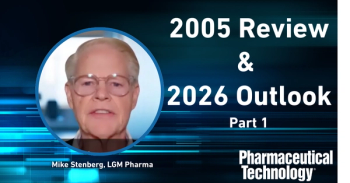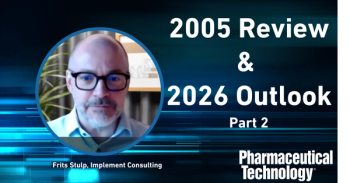
- Pharmaceutical Technology-11-02-2007
- Volume 31
- Issue 11
Inside USP: Annual Scientific Meeting Recap
Representatives from 17 nations sit down to decide upon standards-setting initiatives.
Although the phrase "annual scientific meeting"may have a stilted connotation in the United States, the
In addition, USP's Board of Trustees recently authorized the establishment of a USP site in São Paulo, Brazil, where a regional annual scientific meeting is tentatively scheduled for next summer. USPalso plans to meet in the Middle East next fall.
Although USPis extending its global presence, its largest audience is still in the US. Approximately 300 delegates attended the 2007 scientific meeting in Tampa. Delegates represented US and international pharmaceutical companies, regulatory bodies such as the US Food and Drug Administration and Council of Europe, as well as regulatory and industry organizations in Brazil, Mexico, Japan, the United Arab Emirates, and the United Kingdom. Stakeholders represented 17 nations.
The following provides an overview of the 2007 meeting, including its three most popular tracks.
Topics and tracks
This year's two-day meeting was unique compared with past years because the number of speakers in each session was limited to allow more detailed presentations and longer discussion sessions. Participants could customize their agenda by choosing among five tracks: Quality of Manufactured Medicines—Monographs and Reference Standards; Quality of Manufactured Medicines—General Chapters and Performance Testing; Quality of Manufactured Medicines—Biologics and Biotechnology; Quality of Care; and International Health.
The opening plenary included a number of USP organizational reports. Among the most noteworthy were:the board's authorization of USP's acquisition and publication from March 2008 of Food Chemicals Codex (FCC), and, as noted, the launch of a site in Brazil; the Council of Experts' ongoing work to revise the General Notices of the United States Pharmacopeia–National Formulary and FCC; and a stakeholder report that commented on revisions to "Residual Solvents" <467>, monograph redesign, harmonization, and salt nomenclature, among other topics.
Two plenary speakers addressed current topics in biologics and genomics. Both expressed confidence that advances in proteomics and genomics may positively affect public health. They, however, were also concerned about overly optimistic projections and the absence of standards as biotechnology products and diagnostics move beyond the laboratory into public commerce.
The second day's plenary consisted of presentations by USP's executive vice- president–chief executive officer(EVP–CEO), chief science officer, and chief reference materials officer. The EVP-CEO spoke about core scientific initiatives at USP, particularly the quality of manufactured and compounded foods and medicines and how manufacturers can demonstrate that their products are equivalent to approved products. Because FCC is not an official compendium of the US, establishing standards for food ingredients remains a challenge. One solution would be to move FCC to official status in US regulations.
The chief science officer commented in detail about USP's continuing work on "Residual Solvents" <467>, "Heavy Metals" <231> (bearing in mind that by one estimate the periodic table contains approximately 72 metals of pharmaceutical interest), flexible monographs, and related monograph-related topics. Finally, the chief reference materials officer highlighted the evolution of standards and standards-setting procedures beginning with putative anthropomorphic units (the supposed length of a monarch's foot) to crude physical marks (e.g., two spikes in a stick, used to make scratch marks that represented a meter) to vibrational units (the wavelength of an elemental spectrum) to current concepts about the speed of light in a vacuum. A unifying theme among the speakers was the need for metrologically informed standards that are developed by an international public process of review and comment.
Monographs and reference standards
Sessions in this track began with the US perspective on counterfeiting. USP has promoted the public availability of documentary standards and reference standards as first-line tools in the fight against counterfeit and substandard medications. Although US patients enjoy generally good quality medicines, FDA has received reports that certain so-called lifestyle drugs—or their polymorphs—have been mixed with dietary supplements. The rise of mail-order pharmacies and online medication ordering increase public exposure to medicines that may have been adulterated during passage through distribution markets, which adumbrates USP's call for public standards, including attention to its standards for packaging, storage, and distribution.
Another session in this track addressed uncertainty in reference standards—an important topic as USP moves forward with its plans to offer certified reference materials (CRMs). USP plans to determine the uncertainty of reference materials by applying rigorous metrological approaches and by including a certificate with the resulting CRM that states this uncertainty. The methodological rigor of this program is demanding but also rewarding. It quantifies and reports error, allowing customers who follow International Organization for Standardization (ISO) 17025 to calculate their uncertainty budgets more precisely.
The final session in this track addressed excipients and noted gaps in industry's treatment and understanding of excipients, including the General Notice requirements, the need to update analytical procedures, gaps between formulation scientists' understanding of excipient composition and performance, and the lack of sufficient control of the excipient supply chain. Updates to NF and FCC monographs are underway, and USP is working with the International Pharmaceutical Excipient Council and other stakeholders to promote excipient quality and standards.
General Chapters and performance testing
This track focused on the performance verification test (PVT), which supports horizontal, or international, standards because it is based on interlaboratory collaborative studies that are conducted according to guidances from ISO, and national metrology laboratories. For dissolution testing, USP has proposed moving from an apparatus or basket-based approach to an assembly-based approach that comprises six or eight apparatus. In this manner, USP encourages industry to test samples in assemblies—not individual dosage forms—thereby identifying unacceptable batches rather than unusual samples. The overall goal is to apply current metrologic approaches to PVT as part of a robust attempt to reduce both manufacturer risk (unnecessarily failed batches) and consumer risk (substandard batches released into commerce).
Biologics and biotechnology
The third track discussed bioassays. A bioassay should be based on data that lead to a model of the system under study, thereby generating information about the model system, and in turn leading to a decision about manipulating the system, with subsequent action in the laboratory or clinic. To design a bioassay, one reverses the process, but bioassay design often is complicated by a large number of variables and potential misunderstandings about the goal of the process. A bioassay specification is not necessarily a product specification, although the former contributes to the development of the latter.
USP is actively involved in revising existing General Chapters such as "Design and Analysis of Biological Assays" <111> and is developing many new General Chapters to assist biopharmaceutical practitioners. The overall goal of the USP Biologics and Biotechnology group is to develop procedural and performance standards that will enable biopharmaceutical scientists to characterize, develop, market, and control products with a high degree of certainty that these products maintain their quality attributes.
Conclusion
The 2007 USP Annual Scientific Meeting was notable for the large amount of information shared both in structured podium sessions and during informal exchanges. Looking ahead, USP plans to continue to develop and adapt its meeting format in the service of fostering the exchange of information that will promote the development of stronger international standards and good pharmaceutical care.
To view meeting updates for the United States Pharmacopeia, visit
To view the 2007 USP Annual Scientific Meeting schedule, visit
Roger L. Williams, MD, is executive vice-president and chief executive officer, and Darrell R. Abernethy, MD, PhD,* is chief science officer at the US Pharmacopeia, 12601 Twinbrook Parkway, Rockville, MD 20852-1790, tel. 301.816.8141,
*To whom correspondence should be addressed.
Articles in this issue
about 18 years ago
In the Spotlight November 2007about 18 years ago
Programming a Seamless Supply Chainabout 18 years ago
Investing in High-Potency Manufacturingabout 18 years ago
In the Fieldabout 18 years ago
Mixed Message for Contract Manufacturersabout 18 years ago
Whom Can Patients Rely On?about 18 years ago
Pharma Capsulesabout 18 years ago
Agent in Place: Statistically UnstableNewsletter
Get the essential updates shaping the future of pharma manufacturing and compliance—subscribe today to Pharmaceutical Technology and never miss a breakthrough.




